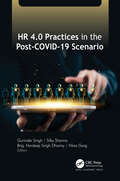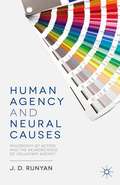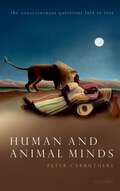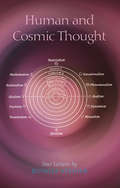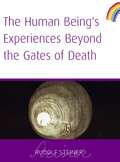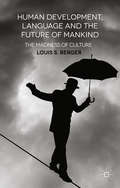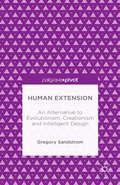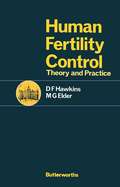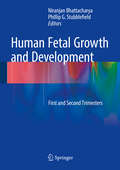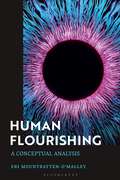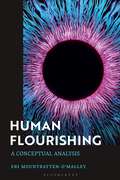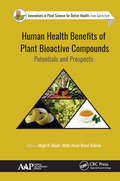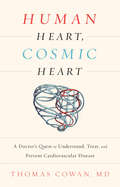- Table View
- List View
HR 4.0 Practices in the Post-COVID-19 Scenario
This new volume examines the dramatic impact of the COVID-19 pandemic and its embrace of the digital revolution on human resources management practices, providing a better understanding of the emerging role of HR 4.0 and equipping HR professionals with the knowledge they need to chart plausible future organizational directions. The book will familiarize readers with the most relevant and latest concepts of HR 4.0 practices, providing tools for solutions to complex problems in managing a multigenerational workforce in this volatile, uncertain, complex, and ambiguous (VUCA) world. The chapter authors discuss an array of topics, including the work-from-home transition, digitization of the workforce, employee work-life balance, task automation technologies via AI, HRM curriculum at schools and universities, employee development, e-recruitment, internal marketing, and more.
Human Agency and Neural Causes: Philosophy of Action and the Neuroscience of Voluntary Agency
by J. RunyanHuman Agency and Neural Causes provides an analysis of our everyday thought about our conduct, and the neuroscience research concerning voluntary agency. J.D. Runyan argues that our findings through neuroscience are consistent with what would be expected if we are, in fact, voluntary agents.
Human and Animal Minds: The Consciousness Questions Laid to Rest
by Peter CarruthersThe continuities between human and animal minds are increasingly well understood. This has led many people to make claims about consciousness in animals, which has often been taken to be crucial for their moral standing. Peter Carruthers argues compellingly that there is no fact of the matter to be discovered, and that the question of animal consciousness is of no scientific or ethical significance. Carruthers offers solutions to two related puzzles. The first is about the place of phenomenal—or felt—consciousness in the natural order. Consciousness is shown to comprise fine-grained nonconceptual contents that are "globally broadcast" to a wide range of cognitive systems for reasoning, decision-making, and verbal report. Moreover, the so-called "hard" problem of consciousness results merely from the distinctive first-person concepts we can use when thinking about such contents. No special non-physical properties—no so-called "qualia"—are involved. The second puzzle concerns the distribution of phenomenal consciousness across the animal kingdom. Carruthers shows that there is actually no fact of the matter, because thoughts about consciousness in other creatures require us to project our first-person concepts into their minds; but such projections fail to result in determinate truth-conditions when those minds are significantly unlike our own. This upshot, however, doesn't matter. It doesn't matter for science, because no additional property enters the world as one transitions from creatures that are definitely incapable of phenomenal consciousness to those that definitely are (namely, ourselves). And on many views it doesn't matter for ethics, either, since concern for animals can be grounded in sympathy, which requires only third-person understanding of the desires and emotions of the animals in question, rather than in first-person empathy.
Human and Animal Minds: The Consciousness Questions Laid to Rest
by Peter CarruthersThe continuities between human and animal minds are increasingly well understood. This has led many people to make claims about consciousness in animals, which has often been taken to be crucial for their moral standing. Peter Carruthers argues compellingly that there is no fact of the matter to be discovered, and that the question of animal consciousness is of no scientific or ethical significance. Carruthers offers solutions to two related puzzles. The first is about the place of phenomenal—or felt—consciousness in the natural order. Consciousness is shown to comprise fine-grained nonconceptual contents that are "globally broadcast" to a wide range of cognitive systems for reasoning, decision-making, and verbal report. Moreover, the so-called "hard" problem of consciousness results merely from the distinctive first-person concepts we can use when thinking about such contents. No special non-physical properties—no so-called "qualia"—are involved. The second puzzle concerns the distribution of phenomenal consciousness across the animal kingdom. Carruthers shows that there is actually no fact of the matter, because thoughts about consciousness in other creatures require us to project our first-person concepts into their minds; but such projections fail to result in determinate truth-conditions when those minds are significantly unlike our own. This upshot, however, doesn't matter. It doesn't matter for science, because no additional property enters the world as one transitions from creatures that are definitely incapable of phenomenal consciousness to those that definitely are (namely, ourselves). And on many views it doesn't matter for ethics, either, since concern for animals can be grounded in sympathy, which requires only third-person understanding of the desires and emotions of the animals in question, rather than in first-person empathy.
Human and Cosmic Thought
by Rudolf SteinerRudolf Steiner demonstrates that there are twelve main philosophical standpoints, and that the future of philosophy rests not upon defending one and refuting the others, but in learning to experience the validity of them all.What convinces us of the truth of a certain point of view? Why do we find it difficult to comprehend viewpoints that differ from our own? What are the inner foundations of our knowledge? In these concentrated and aphoristic lectures, Steiner speaks of twelve main philosophical standpoints, and the importance of understanding each of them. An appreciation of the variety of possible world views not only sharpens and makes more flexible our own powers of thinking, but helps us to overcome a narrow-minded one-sidedness, promoting tolerance of other people and their opinions.Steiner goes on to explain how each standpoint is also coloured by a particular ‘soul mood’, which influences the way we actively pursue knowledge. Several philosophers and their works are characterised in this manner, throwing light on their contributions to human culture. Through such insight into the true nature of human thinking, we are led to understand the quality of cosmic thought and how, in Rudolf Steiner’s words, the human being can be seen as a ‘thought which is thought by the Hierarchies of the cosmos’.
Human and Machine Consciousness
by David GamezConsciousness is widely perceived as one of the most fundamental, interesting and difficult problems of our time. However, we still know next to nothing about the relationship between consciousness and the brain and we can only speculate about the consciousness of animals and machines. Human and Machine Consciousness presents a new foundation for the scientific study of consciousness. It sets out a bold interpretation of consciousness that neutralizes the philosophical problems and explains how we can make scientific predictions about the consciousness of animals, brain-damaged patients and machines. Gamez interprets the scientific study of consciousness as a search for mathematical theories that map between measurements of consciousness and measurements of the physical world. We can use artificial intelligence to discover these theories and they could make accurate predictions about the consciousness of humans, animals and artificial systems. Human and Machine Consciousness also provides original insights into unusual conscious experiences, such as hallucinations, religious experiences and out-of-body states, and demonstrates how ‘designer’ states of consciousness could be created in the future. Gamez explains difficult concepts in a clear way that closely engages with scientific research. His punchy, concise prose is packed with vivid examples, making it suitable for the educated general reader as well as philosophers and scientists. Problems are brought to life in colourful illustrations and a helpful summary is given at the end of each chapter. The endnotes provide detailed discussions of individual points and full references to the scientific and philosophical literature.
Human and Machine Consciousness
by David GamezConsciousness is widely perceived as one of the most fundamental, interesting and difficult problems of our time. However, we still know next to nothing about the relationship between consciousness and the brain and we can only speculate about the consciousness of animals and machines. Human and Machine Consciousness presents a new foundation for the scientific study of consciousness. It sets out a bold interpretation of consciousness that neutralizes the philosophical problems and explains how we can make scientific predictions about the consciousness of animals, brain-damaged patients and machines. Gamez interprets the scientific study of consciousness as a search for mathematical theories that map between measurements of consciousness and measurements of the physical world. We can use artificial intelligence to discover these theories and they could make accurate predictions about the consciousness of humans, animals and artificial systems. Human and Machine Consciousness also provides original insights into unusual conscious experiences, such as hallucinations, religious experiences and out-of-body states, and demonstrates how ‘designer’ states of consciousness could be created in the future. Gamez explains difficult concepts in a clear way that closely engages with scientific research. His punchy, concise prose is packed with vivid examples, making it suitable for the educated general reader as well as philosophers and scientists. Problems are brought to life in colourful illustrations and a helpful summary is given at the end of each chapter. The endnotes provide detailed discussions of individual points and full references to the scientific and philosophical literature.
Human Being's Experiences Beyond The Gates of Death
by Rudolf SteinerA single lecture taken from the volume Life Beyond Death.
Human Capacities and Moral Status (Philosophy and Medicine #108)
by Russell DiSilvestroMany debates about the moral status of things—for example, debates about the natural rights of human fetuses or nonhuman animals—eventually migrate towards a discussion of the capacities of the things in question—for example, their capacities to feel pain, think, or love. Yet the move towards capacities is often controversial: if a human’s capacities are the basis of its moral status, how could a human having lesser capacities than you and I have the same "serious" moral status as you and I? This book answers this question by arguing that if something is human, it has a set of typical human capacities; that if something has a set of typical human capacities, it has serious moral status; and thus all human beings have the same sort of serious moral status as you and I. Beginning from what our common intuitions tell us about situations involving "temporary incapacitation"—where a human organism has, then loses, then regains a certain capacity—this book argues for substantive conclusions regarding human fetuses and embryos, humans in a permanent vegetative state, humans suffering from brain diseases, and humans born with genetic disorders. Since these conclusions must have some impact on our ongoing moral and political debates about the proper treatment of such humans, this book will be useful to professionals and students in philosophy, bioethics, law, medicine, and public policy.
Human Centered Robot Systems: Cognition, Interaction, Technology (Cognitive Systems Monographs #6)
by Rüdiger Dillmann Martin Buss Helge Ritter Gerhard SagererHuman Centered Robotic Systems must be able to interact with humans such that the burden of adaptation lies with the machine and not with the human. This book collates a set of prominent papers presented during a two-day conference on "Human Centered Robotic Systems" held on November 19-20, 2009, in Bielefeld University, Germany. The aim of the conference was to bring together researchers from the areas of robotics, computer science, psychology, linguistics, and biology who are all focusing on a shared goal of cognitive interaction. A survey of recent approaches, the current state-of-the-art, and possible future directions in this interdisciplinary field is presented. It provides practitioners and scientists with an up-to-date introduction to this dynamic field, with methods and solutions that are likely to significantly impact on our future lives.
Human Development, Language and the Future of Mankind: The Madness of Culture
by L. BergerDrawing on and integrating unorthodox thought from a broad range of disciplines including clinical psychology, linguistics, philosophy, natural science and psychoanalysis, this book offers a provocative, original analysis of the global threats to our survival, and proposes a remedy.
Human Embryo Transfer
by Gautam N. Allahbadia Claudio F. ChillikThis concise work on embryo transfer is yet another contribution to the persevering effort to disseminate latest information on the science and skill of performing a traumatic and successful embryo transfer. It is the most critical culmination of the assisted reproductive technology (ART) stimulation cycle, and a rate-limiting step in dictating the success of treatment. The well-worded chapters draw the reader’s attention to significant aspects before initiating the actual embryo transfer, such as possible causes of failure at the embryo transfer stage, uterine evaluation, mock embryo transfer (ET), experience of the physician, and the use of ultrasound-guidance to monitor ET. The protocol for difficult transfers, variables that affect the success of ET, and the influence of the catheter used for ET have also been dealt with. The unique feature of this book is its pragmatic approach that can translate into solutions to the numerous frustrating ART failures that more often than not, may be attributed to an inefficient ET procedure. It helps the reader understand the integrity of embryo transfer, unravel its obvious simplicity and bridge the success between the several steps of ART. By highlighting the impeding problems associated with ET procedure and providing valid, scientific solutions, this stimulating edition will help the readers improve the ART success rates in their clinical practice.
Human Extension: An Alternative to Evolutionism, Creationism and Intelligent Design
by Gregory SandstromThis book proposes a new angle on the controversy over evolution as a biological theory, creation as a theological/worldview doctrine and evolutionism, creationism and Intelligent Design theory as social ideologies. Rather than presenting a polemic that will enrage or delight one camp or another, this book proposes that a cease-fire is possible.
Human Factors in Privacy Research
by Nina Gerber Alina Stöver Karola MarkyThis book covers topics needed to be considered in research around usable privacy. The book starts from a psychological perspective and introduces readers to basic behavioral theories and models that can explain end-user privacy behavior (including the “privacy paradox”) on a theoretical level. Subsequently, an introduction to different study methods (e.g., experiment, survey, interviews, co-creation) used in usable privacy research is given. Based on this, different methodological aspects, such as identifying appropriate questionnaires, and applying User-Centered Design, will be discussed. Finally, the book describes application areas for privacy research such as dark patterns and presents solutions for privacy protection, e.g., regarding consent-giving and PETs. The book aims to bring together the different research approaches to the topic of usable privacy, which often originate from computer science, psychology, and law, and provide a methodologically sound basis for researchers who want to delve deeper into this topic.This is an open access book.
Human Fertility Control: Theory and Practice
by D F Hawkins M G ElderHuman Fertility Control: Theory and Practice reviews the theoretical and practical concepts of human fertility control and covers topics ranging from hormonal contraception and barrier methods to intra-uterine contraception, legal abortion, and sterilization. Family planning is also discussed, with emphasis on contraception in patients with medical disorders. Comprised of 21 chapters divided into seven sections, this book begins with an introduction to hormonal contraceptives, including the oral ones such as combined pills, sequential pills, and low-dose progestagen pills, along with injectable hormones and implants. The following chapters explore the clinical pharmacology of estrogens and progestagens; combined oral contraceptives; and the relative effectiveness and risks of hormonal contraception. Barrier methods such as condoms, spermicides, and coitus interruptus (male withdrawal) are also described. The remaining chapters examine intra-uterine devices and complications of intra-uterine contraception; issues surrounding legal abortion; and methods of operative sterilization. This monograph will be a valuable resource for obstetricians and gynecologists, medical and postgraduate students, nurses and midwives concerned with family planning, and specialists in training.
Human Fetal Growth and Development: First and Second Trimesters
by Niranjan Bhattacharya Phillip G. StubblefieldThis unique book delves into the mysteries of human fetal growth and maturation. Growing knowledge in genetics indicates that factors that impact on/influence fetal growth and maturation may have a role in determining a person’s health and disease in later years. Placental, maternal, environmental, nutrient as well as fetal genome factors each play a role in producing a healthy, unhealthy or abnormal baby. A study of fetal growth and maturation is therefore basic to the understanding of why fetal growth problems occur, what implications these can have for adult disease, and how clinical intervention can help to reverse growth problems. The present study will be comprehensive and will be a major contribution to the fields of gynecology, genetics, obstetrics, biochemistry, molecular biology and clinical medicine. It will include cutting edge research in the field as well as explorations on clinical interventions in fetal growth, which will not only add to existing knowledge but also prompt future research. The two Editors are distinguished in their fields and both have extensive clinical and research experience. They felt that they could use their expertise to create a book that will help students, practitioners, researchers and others to understand the subject of gestation, growth and maturation and its implications from a multi-dimensional point of view, which will help them develop their own expertise in a cutting-edge and developing field. They have brought together medical scientists, clinical practitioners, embryologists, endocrinologists, immunologists, gynecologists, obstetricians, reproductive and molecular biologists, geneticists and many others to create a state-of-the-art book on a subject with increasing demand for further knowledge. It aims to integrates different disciplines to give a holistic view of human fetal growth maturation.
Human Flourishing: A Conceptual Analysis
by Eri Mountbatten-O’MalleyIn this first systematic reconstruction of the concept of human flourishing, Eri Mountbatten-O'Malley addresses the central problems with the treatment of the concept in psychology, education, policy and science. Drawing on Wittgenstein and his followers, he develops a sophisticated methodology of conceptual analysis and makes the case for paying closer attention to complex human contexts, purposes and uses.Adopting a conceptual approach, informed by fundamental insights adapted from Wittgenstein's philosophy of language, Mountbatten-O'Malley highlights the key features and connections in the conceptual landscape of human flourishing, such as humanness, agency, personal growth, happiness and meaning. He considers the extent to which any claim to knowledge is reliant on a putative human nature, what that nature is, and how we can better understand such notions.Re-humanizing current research on the concept that is technicalized and detached from ordinary uses, this volume takes the 'human' in conceptions of human flourishing seriously.
Human Flourishing: A Conceptual Analysis
by Eri Mountbatten-O’MalleyIn this first systematic reconstruction of the concept of human flourishing, Eri Mountbatten-O'Malley addresses the central problems with the treatment of the concept in psychology, education, policy and science. Drawing on Wittgenstein and his followers, he develops a sophisticated methodology of conceptual analysis and makes the case for paying closer attention to complex human contexts, purposes and uses.Adopting a conceptual approach, informed by fundamental insights adapted from Wittgenstein's philosophy of language, Mountbatten-O'Malley highlights the key features and connections in the conceptual landscape of human flourishing, such as humanness, agency, personal growth, happiness and meaning. He considers the extent to which any claim to knowledge is reliant on a putative human nature, what that nature is, and how we can better understand such notions.Re-humanizing current research on the concept that is technicalized and detached from ordinary uses, this volume takes the 'human' in conceptions of human flourishing seriously.
Human Flourishing, Spiritual Awakening and Cultural Renewal: Personal and Communal Challenges
by Francisco Díaz Estrada Catalina Elena Dobre Rafael García PavónThis book seeks to generate a theoretical and a reflective framework to re-connect people with culture and spirituality. It seeks to recreate important links between these domains to provide interpretative, foundational, and ethical perspectives. It is distinctive in that it focusses on the challenges that humanity is facing at a cultural, social, moral, and spiritual level. It provides a philosophical understanding of humanity from a humanistic and multidisciplinary perspective (encompassing ethics, language, art/cinema, political, cultural and gender approaches) and offers a variety of ways of how we can rethink our culture and our society for the future.
Human Gametes and Preimplantation Embryos: Assessment and Diagnosis
by David K. Gardner, Denny Sakkas, Emre Seli and Dagan WellsIn recent years, the advancing science and increasing availability of assisted reproduction have given new hope to infertile couples. However, the use of IVF and ART has also led to marked increases in the number of multiple-infant live births. This poses a public health concern, as these neonates have a higher rate of pre-term delivery, compromising their survival chances and increasing their risk of lifelong disability. By optimizing the selection of gametes and embryos with high probabilities of implantation, it is possible to reduce the number of embryos transferred and, by extension, the number of high-risk multiple gestations, while maintaining or increasing pregnancy rates. Human Gametes and Preimplantation Embryos: Assessment and Diagnosis provides a broad yet concise overview of established and developing methodologies for assessment of gamete and embryo viability in assisted reproduction. This book elucidates the best practices for precisely selecting viable specimens based on morphology and cleavage rate and covers the spectrum of emerging adjunctive technologies for predicting reproductive potential. The authors present their extensive knowledge of “omics” approaches (genomics, transcriptomics, proteomics, and metabolomics), with unbiased delineation of the associated advantages and potential pitfalls. This valuable clinical resource is well suited to infertility specialists, Ob/Gyn physicians, IVF laboratory technicians, and researchers in the fields of embryology and reproductive medicine.
Human Health Benefits of Plant Bioactive Compounds: Potentials and Prospects (Innovations in Plant Science for Better Health)
by Megh R. Goyal Hafiz Ansar Hafiz Ansar Rasul SuleriaFocusing on the importance of functional foods and their secondary metabolites for human health, this volume presents new insights with scientific evidence on the use of functional foods in the treatment of certain diseases. The plants covered and their bioactive compounds are easily accessible and are believed to be effective with fewer side effects in comparison with modern drugs in the treatment of different diseases. The plants contain chemical compounds that can modify and modulate biological systems, eliciting therapeutic effects. Some plants and derived products mentioned include black carrot, olive oil, citrus peel, grapes, candy leaf, cereals and grains, and green and black tea. The volume is divided into four sections that cover these topics: Functional foods for human health: the available sources, biochemistry, structural composition, and different biological activities, especially antioxidant activity. Pharmacological aspects of fruits and vegetables: the extraction of bioactive molecules, phytochemistry, and biological activities of a selection of plants. Pharmacological aspects of natural products: bioactive compounds, structural attributes, bioactivity of anthocyanin, piceatannol, and a review of the ethnobotany and medicinal properties of green and black tea. Pharmacological aspects of cereals and grains: the health benefits of flaxseed, wheatgrass juice, and use and therapeutic potential as supplements for disease management.
Human Health Benefits of Plant Bioactive Compounds: Potentials and Prospects (Innovations in Plant Science for Better Health)
by Megh R. Goyal Hafiz Ansar Rasul SuleriaFocusing on the importance of functional foods and their secondary metabolites for human health, this volume presents new insights with scientific evidence on the use of functional foods in the treatment of certain diseases. The plants covered and their bioactive compounds are easily accessible and are believed to be effective with fewer side effects in comparison with modern drugs in the treatment of different diseases. The plants contain chemical compounds that can modify and modulate biological systems, eliciting therapeutic effects. Some plants and derived products mentioned include black carrot, olive oil, citrus peel, grapes, candy leaf, cereals and grains, and green and black tea. The volume is divided into four sections that cover these topics: Functional foods for human health: the available sources, biochemistry, structural composition, and different biological activities, especially antioxidant activity. Pharmacological aspects of fruits and vegetables: the extraction of bioactive molecules, phytochemistry, and biological activities of a selection of plants. Pharmacological aspects of natural products: bioactive compounds, structural attributes, bioactivity of anthocyanin, piceatannol, and a review of the ethnobotany and medicinal properties of green and black tea. Pharmacological aspects of cereals and grains: the health benefits of flaxseed, wheatgrass juice, and use and therapeutic potential as supplements for disease management.
Human Heart, Cosmic Heart: A Doctor’s Quest to Understand, Treat, and Prevent Cardiovascular Disease
by Dr Thomas CowanThomas Cowan was a 20-year-old Duke grad—bright, skeptical, and already disillusioned with industrial capitalism—when he joined the Peace Corps in the mid-1970s for a two-year tour in Swaziland. There, he encountered the work of Rudolf Steiner and Weston A. Price—two men whose ideas would fascinate and challenge him for decades to come. Both drawn to the art of healing and repelled by the way medicine was—and continues to be—practiced in the United States, Cowan returned from Swaziland, went to medical school, and established a practice in New Hampshire and, later, San Francisco. For years, as he raised his three children, suffered the setback of divorce, and struggled with a heart condition, he remained intrigued by the work of Price and Steiner and, in particular, with Steiner’s provocative claim that the heart is not a pump. Determined to practice medicine in a way that promoted healing rather than compounded ailments, Cowan dedicated himself to understanding whether Steiner’s claim could possibly be true. And if Steiner was correct, what, then, is the heart? What is its true role in the human body? In this deeply personal, rigorous, and riveting account, Dr. Cowan offers up a daring claim: Not only was Steiner correct that the heart is not a pump, but our understanding of heart disease—with its origins in the blood vessels—is completely wrong. And this gross misunderstanding, with its attendant medications and risky surgeries, is the reason heart disease remains the most common cause of death worldwide. In Human Heart, Cosmic Heart, Dr. Thomas Cowan presents a new way of understanding the body’s most central organ. He offers a new look at what it means to be human and how we can best care for ourselves—and one another.
Human in Vitro Fertilization and Embryo Transfer
by Don P. Wolf Martin M. QuigleyThe births of more than 100 apparently normal infants at term following pregnancies initiated by in vitro fertilization and embryo transfer testifies to the successful clinical application of insights obtained from studies in reproductive biology over the last 20 years. In women, these studies have included: 1) characterization of the changes in blood hormone profiles throughout ovulatory menstrual cycles; 2) documentation of the hormonal composition of antral fluid in developing and degenerating preovulatory follicles; 3) correlation of these observations with the state of oocyte maturation and the fertilizability of the oocyte; 4) application of pharmacologic agents for perturbing the normal hormone profiles to regulate the number of preovulatory follicles developing and the time of ovulation; and 5) development of non-invasi ve methods for monitoring follicular development. Optimizing methods for maturing and fertilizing eggs, for moni toring normal development in vi tro, and for transferring and achieving implantation of embryos are continuing concerns of physicians and scientists responsible for extant programs. In addition, all serious students of reproductive biology should critically examine every facet of the processes which must concatenate to assure birth of normal infants following pregnancies achieved by these methods. However, the literature which contains the informational substrate is dispersed widely in a plethora of journals not always readily accessible. Bringing the essentials together facilitates both rapid retrieval of data and access to relevant literature.
The Human Mind through the Lens of Language: Generative Explorations
by Nirmalangshu MukherjiMost living forms in nature display various cognitive abilities in their behaviour. However, except for humans, no other animal builds fires and wheels, navigates with maps and tells stories to other conspecifics. We can witness this unique feature of the human mind in almost everything humans do, such as painting, singing and cooking; there is an underlying sense of unity in the generative part of these systems despite wide differences in what they are about.This book introduces, defends and develops a novel philosophical approach to the study of the generative mind. Nirmalangshu Mukherji argues for a single, species-specific generative principle that accounts for the human ability to combine symbolic forms without bound in each domain that falls under the generative mind.
